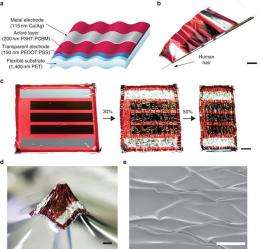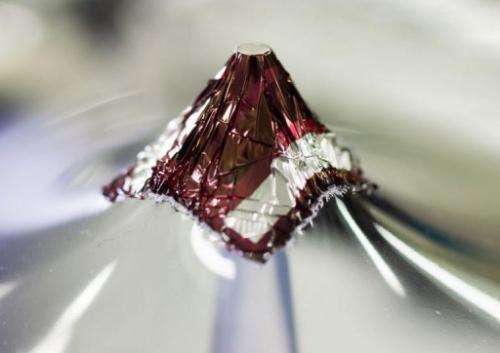Scientists develop ultra-thin solar cells

Austrian and Japanese researchers on Wednesday unveiled solar cells thinner than a thread of spider silk that are flexible enough to be wrapped around a single human hair.
The thin-film device, comprising electrodes on a plastic foil, is about 1.9 micrometers thick, a tenth the size of the thinnest solar cells currently available, the researchers said.
"The total thickness of this device is less than a typical thread of spider silk," the researchers said in a report carried by online science journal Nature Communications.
"Being ultra-thin means you don't feel its weight and it is elastic," said one of the researchers, Tsuyoshi Sekitani from the University of Tokyo.
"You could attach the device to your clothes like a badge to collect electricity (from the sun)... Elderly people who might want to wear sensors to monitor their health would not need to carry around batteries," Sekitani told AFP.

The research was done jointly by Martin Kaltenbrunner, Siegfried Bauer and other researchers from Johannes Kepler University of Austria as well as Sekitani and other contributors from University of Tokyo.
Sekitani said it was possible to make the cells bigger.
"Power generation by solar cells increases with their size. As this device is soft, it is less prone to damage by bending even if it gets bigger," he said.
Sekitani said the team hoped to increase the rate at which the device converts sunlight into electricity and put it to practical use in around five years.
More information: Ultrathin and lightweight organic solar cells with high flexibility, Nature Communications 3, Article number: 770
Abstract
Application-specific requirements for future lighting, displays and photovoltaics will include large-area, low-weight and mechanical resilience for dual-purpose uses such as electronic skin, textiles and surface conforming foils. Here we demonstrate polymer-based photovoltaic devices on plastic foil substrates less than 2 μm thick, with equal power conversion efficiency to their glass-based counterparts. They can reversibly withstand extreme mechanical deformation and have unprecedented solar cell-specific weight. Instead of a single bend, we form a random network of folds within the device area. The processing methods are standard, so the same weight and flexibility should be achievable in light emitting diodes, capacitors and transistors to fully realize ultrathin organic electronics. These ultrathin organic solar cells are over ten times thinner, lighter and more flexible than any other solar cell of any technology to date.
Journal information: Nature Communications
(c) 2012 AFP


















